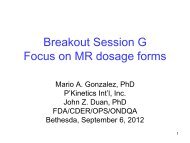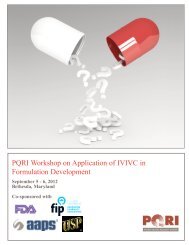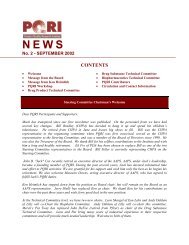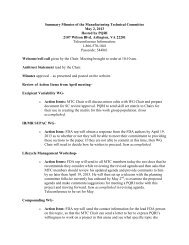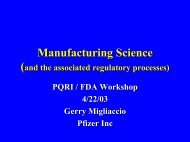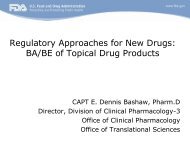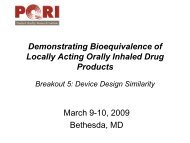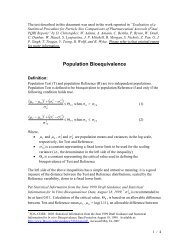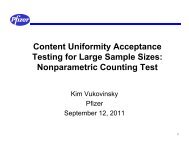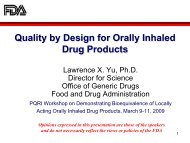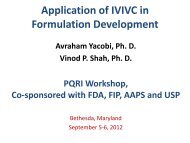Case Study RMWG-04 draft 05 Feb 08 (PDF) - PQRI
Case Study RMWG-04 draft 05 Feb 08 (PDF) - PQRI
Case Study RMWG-04 draft 05 Feb 08 (PDF) - PQRI
You also want an ePaper? Increase the reach of your titles
YUMPU automatically turns print PDFs into web optimized ePapers that Google loves.
<strong>Case</strong> <strong>Study</strong>: Internal GMP Auditing (<strong>Study</strong> # <strong>RMWG</strong>-<strong>04</strong>)Defining the RiskQuestionSelecting a RiskAssessmentMethodRisk Assessment(RiskIdentification,Analysis andEvaluation)The risk question developed for the subject case study is:What are the appropriate back-up inactivation methods(procedures) that are operationally feasible and provide anappropriate level of decontamination capability that can beutilized in the fermentation suite to inactivate BL2 waste andequipment when the inactivation autoclave is unavailable?Selection of a back-up inactivation procedure is a precise exerciserequiring an objective evaluation of the effectiveness of proposedprocedures at inactivating the BL2 organism along withdemonstration of consistent execution of these procedures eachtime they are performed.HACCP is a risk assessment tool that can be proactively utilizedto identify and implement process controls that consistently andeffectively prevent hazards from occurring through evaluation ofcritical procedural limits and determination of how they will beroutinely achieved. Since it is essential that the back-upinactivation procedures prevent the release of the BL2 organismoutside of the fermentation suite HACCP was selected as the riskassessment tool to use to determine the appropriate preventativecontrols.The risk methodology selected for the subject case study is:Risk Identification -HACCPFor this evaluation there was only one hazard for consideration,the BL2 organism, thus the HACCP process was significantlystreamlined. Due to operator safety considerations and the highlevel of regulatory requirements for control of pathogenic BL2organisms. The hazard was always considered to be significantin this case study. (Table 1).Page 2 of 4
<strong>Case</strong> <strong>Study</strong>: Internal GMP Auditing (<strong>Study</strong> # <strong>RMWG</strong>-<strong>04</strong>)Risk Analysis and Evaluation –Each proposed inactivation mechanism or procedure was deemedcritical (Table 1) since they were proposed as back-ups for theprimary autoclave inactivation method (which was itself deemedcritical). The evaluation of the effectiveness of the procedures aswell as how they will be controlled such that the criticalparameters will be consistently achieved is shown in Table 2.Risk ControlRiskDocumentationand ControlIn this case study, identifying effective back-up inactivationmethods for times when the primary inactivation autoclave isunavailable for use reduces the risk of a breach of containment inthe facility. Table 2 demonstrates that the back-up proceduresthat were identified are effective and can be consistentlycontrolled. Table 2 also indicates that additional more detailedprocedural controls and more clearly defined functional arearesponsibilities, beyond what is currently outlined in the back-upprocedures, will be required to ensure that proper containment ofthe BL2 organism is maintained. These additional proceduralcontrols are identified in the “recommended actions” column.For this case study, the outputs of the risk assessment process,including recommendations for additional procedural andfunctional area controls, were documented in a risk assessmentreport. This report becomes part of the operating history for themanufacturing facility and the associated product. Eachfunctional area impacted by the results of the risk assessmentreviewed and signed off on the results and recommendations.The project team assumed responsibility for implementation of therecommendations that arose from the QRM process.Page 3 of 4



